
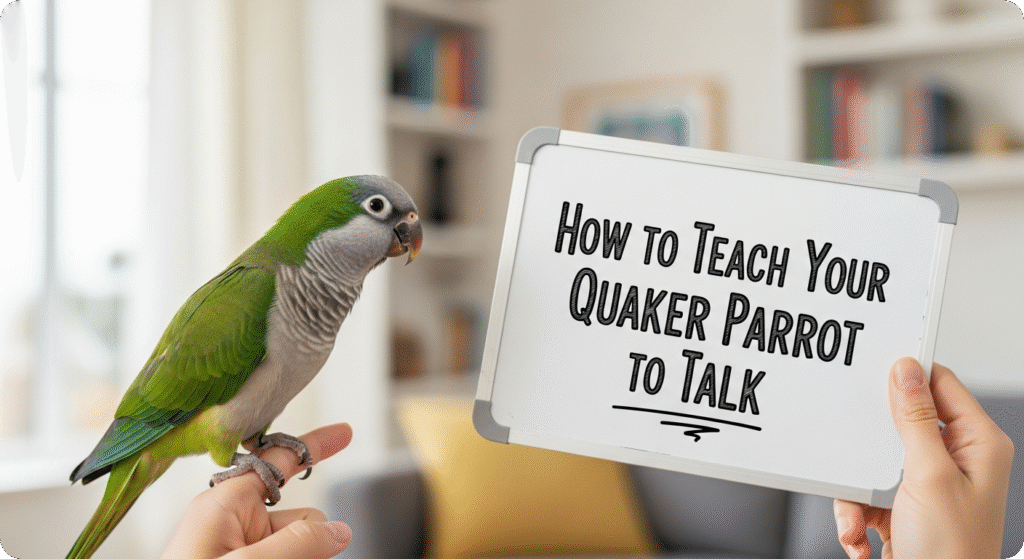
Introduction: Discovering the Amazing Vocal Talents of Quaker Parrots
Quaker parrot, also known as monk parakeets, have earned their reputation as one of the most accomplished talking birds in the avian world.
These medium-sized parrots possess an extraordinary ability to mimic human speech with remarkable clarity, often developing vocabularies that rival even larger parrot species. Their exceptional vocal capabilities, combined with their social intelligence and playful personalities, make them highly sought-after companions for bird enthusiasts.
What truly sets Quaker parrots apart is not just their ability to repeat words, but their demonstrated capacity to use language appropriately in context, showing a level of understanding that fascinates researchers and owners alike.
The journey of developing your Quaker parrot’s speaking abilities is about more than teaching tricks; it’s about building a deeper bond and creating a unique form of communication between you and your feathered friend.
This comprehensive guide will explore every aspect of Quaker parrot talking, from the biological foundations of their vocal abilities to advanced training techniques that can help your bird reach its full potential.
Whether you’re a new Quaker parrot owner or looking to enhance your existing bird’s vocabulary, understanding the principles of vocal training will help you unlock the remarkable speech capabilities of these intelligent birds.
The Science Behind Quaker Parrot Talking Abilities
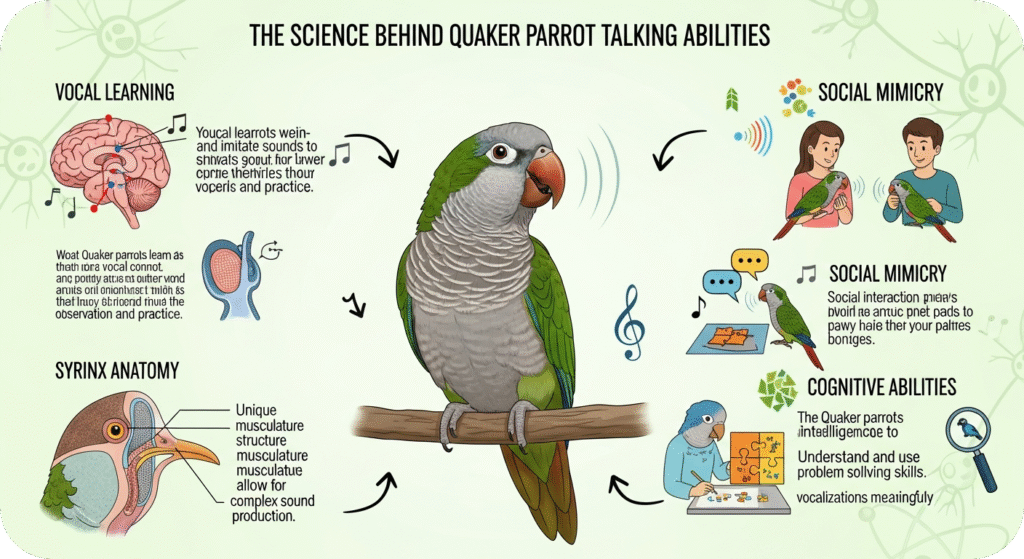
Biological Foundations of Vocal Learning
Quaker parrots possess several biological advantages that contribute to their exceptional talking abilities. Like other parrots, they produce sounds using a unique vocal organ called the syrinx, located where the trachea divides into the lungs.
This complex structure allows for independent control of sounds from each bronchial tube, enabling parrots to produce a wide range of tones and frequencies.
Unlike humans who use vocal cords in the larynx, the syrinx gives parrots superior vocal flexibility, allowing them to mimic everything from human speech to household noises with astonishing accuracy.
The brain structure of parrots also contributes significantly to their vocal capabilities. Research has revealed that parrots have a larger forebrain compared to other birds, packing more neurons into this region responsible for higher-order thinking and problem-solving
This neurological development supports the complex cognitive processes required for vocal learning and mimicry.
The presence of a specialized “song system” in their brains, similar to what’s found in humans, facilitates both the learning and production of complex vocalizations.
This sophisticated neural architecture enables Quaker parrots not just to mimic sounds, but potentially to understand contextual usage and develop meaningful communication.
Research on Quaker Parrot Intelligence and Social Cognition
Scientific studies have provided fascinating insights into the cognitive abilities of Quaker parrots that directly relate to their talking capabilities.
Research led by Elizabeth Hobson at the National Institute for Mathematical and Biological Synthesis explored the social intelligence of Quaker parrots, revealing their sophisticated understanding of social hierarchies and interactions .
These birds don’t just react to immediate stimuli; they observe and analyze social interactions between other birds, then adjust their own behavior based on these observations.
This capacity for social learning translates directly to their ability to learn human language. Quaker parrots can make connections between words, situations, and outcomes, allowing them to use vocabulary appropriately rather than just randomly.
Their brain structure supports what scientists call “learning by association,” enabling them to connect specific words with corresponding actions, objects, or emotions
. This cognitive capacity means that with proper training, your Quaker parrot isn’t just mindlessly repeating sounds but potentially developing a functional understanding of how language works within your household environment.
Understanding Quaker Parrot Vocal Capabilities

Comparison with Other Talking Bird Species
When evaluating the talking abilities of Quaker parrots, it’s helpful to understand how they compare to other known talking bird species.
While African Grey parrots often receive the most attention for their exceptional vocabulary and apparent comprehension, Quaker parrots hold their own as impressive vocalists, particularly considering their smaller size and more accessible price point.
Table: Quaker Parrot Talking Ability Comparison with Other Species
| Bird Species | Talking Ability | Voice Clarity | Contextual Understanding | Learning Speed |
|---|---|---|---|---|
| Quaker Parrot | Excellent | Very clear | Demonstrates contextual use | Fast learner |
| African Grey | Exceptional | Excellent | High apparent comprehension | Moderate to fast |
| Amazon Parrot | Excellent | Good to excellent | Moderate contextual use | Moderate |
| Budgerigar | Good | Variable clarity | Limited contextual use | Fast |
| Cockatiel | Fair to good | Less clear | Limited contextual use | Moderate |
As the table demonstrates, Quaker parrots rank among the top talking bird species, with particular strengths in voice clarity and contextual application of learned vocabulary. Many owners report that their Quaker parrots develop voices that are remarkably human-like and easier to understand than many other parrot species . This combination of factors makes them an excellent choice for those particularly interested in a bird with strong talking potential.
Factors That Influence Individual Talking Ability
While Quaker parrots as a species have impressive vocal capabilities, individual talking ability can vary significantly based on several factors:
- Socialization: Hand-fed Quaker parrots that have been well-socialized from a young age typically develop better talking skills than parent-raised birds . Early positive human interaction builds trust and encourages vocal communication.
- Personality: Just like humans, individual Quaker parrots have distinct personalities. Some are naturally more outgoing and vocal, while others may be quieter and more reserved. Understanding your bird’s unique personality helps tailor your training approach.
- Age: While parrots of any age can learn new words, younger birds (under one year) typically show more enthusiasm for picking up new vocabulary and sounds . That said, older Quakers can still become excellent talkers with patience and consistent training.
- Environment: Birds in stimulating environments with regular social interaction tend to develop better verbal skills than those in quiet, isolated settings. The amount and quality of human interaction directly influence vocabulary development.
- Gender: While both male and female Quaker parrots can become excellent talkers, some owners and breeders report that males may be slightly more inclined to develop large vocabularies. However, individual variation is significant, and plenty of female Quakers are champion talkers.
Understanding these variables helps set realistic expectations and allows you to create the optimal environment for your Quaker parrot to develop its speaking abilities to their fullest potential.
Creating the Optimal Environment for Quaker Parrot Talking

Social Requirements for Vocal Development
Quaker parrots are inherently social creatures that thrive on interaction and communication. In the wild, they live in large flocks and maintain constant vocal contact with other members of their community . This natural inclination toward social vocalization forms the foundation of their ability to learn human speech. To encourage talking development, you must fulfill their social needs by integrating them into your family’s daily life.
Position your Quaker’s cage in a main living area where household activities naturally occur, but avoid placing it in the direct path of heavy traffic or noisy appliances . The goal is to allow your bird to feel part of the family without becoming overwhelmed. Quakers want to be “a part of the action,” and this inclusion motivates them to communicate using the sounds of their human flock . Regular, meaningful interaction is far more effective than simply leaving a radio or television on, as these artificial sources don’t provide the interactive element essential for true vocal learning.
Habitat Setup to Encourage Vocalization
The physical environment you create for your Quaker parrot significantly impacts their comfort level and willingness to vocalize. Several factors contribute to an optimal habitat for talking development:
- Cage Size and Placement: Select a cage that allows for full wing-flapping with dimensions of at least 18″ x 18″ x 18″ as a minimum . Place the cage in a corner of your main living space where your bird can observe household activities while having the security of a protected retreat.
- Environmental Enrichment: Provide a variety of bird-safe toys that encourage manipulation and problem-solving, but avoid cluttering the cage so heavily that movement is restricted . Rotate toys regularly to maintain novelty and mental stimulation, which supports cognitive development essential for advanced vocal skills.
- Safety and Security: Ensure your Quaker feels safe in its environment by avoiding sudden loud noises, unpredictable movements, or exposure to potential predators like cats and dogs . A stressed bird is unlikely to practice new vocalizations, while a secure and comfortable Quaker will happily experiment with sounds.
- Consistent Routine: Establish predictable daily routines for feeding, playtime, and training. The security derived from knowing what to expect throughout the day encourages confidence, which in turn supports vocal experimentation and learning.
By creating an environment that addresses both the social and physical needs of your Quaker parrot, you establish the foundation upon which successful talking training can be built.
Fundamental Training Techniques for Quaker Parrot Talking
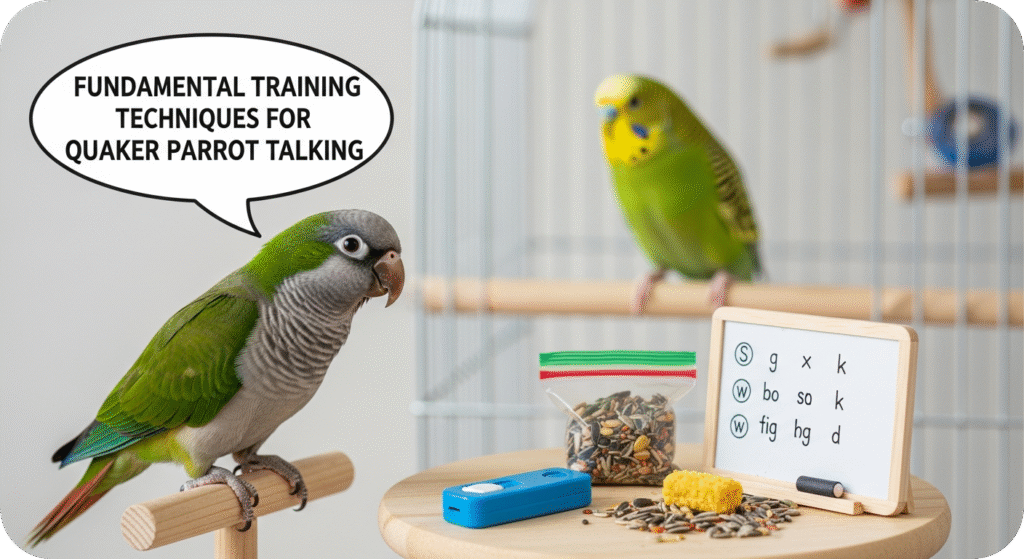
Establishing Trust and Bonding
Before formal talking training can begin, it’s essential to establish a strong bond of trust with your Quaker parrot. These intelligent birds will not readily learn from someone they don’t trust or feel connected to. The bonding process begins from the first day you bring your bird home and continues throughout your relationship.
Start by spending time near your Quaker’s cage without making direct demands for interaction. Talk softly to your bird throughout the day, using a consistent tone and volume . Avoid sudden movements or forced interactions, which can damage trust. Instead, let your parrot set the pace for physical interaction. Offering favorite treats from your hand without requiring stepping up can build positive associations with your presence. This foundation of trust is critical because a Quaker parrot that feels secure with its owner is more likely to attempt new vocalizations without fear or hesitation.
Many Quaker parrots respond particularly well to soft singing or musical sounds during the bonding process . Their natural curiosity and appreciation for music often draw them toward humans who provide these pleasant auditory experiences. The trust-building phase requires patience, especially with rescued or older birds who may have previous negative experiences with humans. However, even the most cautious Quakers typically respond to consistent, gentle interaction over time.
Basic Training Principles and Methodologies
Successful talking training relies on several fundamental principles of parrot learning and behavior:
- Positive Reinforcement: Quaker parrots respond exceptionally well to positive reinforcement techniques . When your bird attempts a new word or sound, immediately reward it with a small, favorite treat, enthusiastic praise, or physical affection (if your bird enjoys this). The immediate positive association encourages repetition of the desired vocalization.
- Consistency and Repetition: Learning new words requires consistent repetition. Choose a specific time each day for focused training sessions when your bird is most alert and receptive, typically in the morning or early evening . Short, frequent sessions of 10-15 minutes are more effective than longer, infrequent ones.
- Clear Enunciation: When introducing new words, speak slowly and clearly, emphasizing the distinct sounds that form each word. Maintain a consistent tone and volume, as Quaker parrots will mimic not just the word but the exact tone and inflection you use .
- Timing and Context: Associate words with specific contexts or actions to enhance understanding. For example, say “hello” each time you enter the room, or “good night” when covering the cage in the evening. This contextual association helps your Quaker understand meaning rather than just mimicking sounds.
- Patience and Realistic Expectations: Some birds pick up words within days, while others may take weeks or months to master their first word. Avoid showing frustration if progress is slow, as negative emotions can create setbacks in training. Celebrate small improvements and understand that each bird learns at its own pace.
These fundamental principles create the framework for all specific talking exercises and techniques. Mastering these basics will make the training process more effective and enjoyable for both you and your Quaker parrot.
Step-by-Step Initial Word Training
Teaching your Quaker parrot its first words requires a systematic approach that builds confidence alongside vocabulary. Follow these steps for optimal results:
- Word Selection: Begin with simple, one or two-syllable words that contain sounds natural for parrots to produce. Excellent starter words include “hello,” “hi,” “bye-bye,” your bird’s name, or simple words like “good.” Choose words you can associate with specific actions or situations to provide contextual clues.
- Consistent Modeling: Say the chosen word clearly and enthusiastically every time you approach your Quaker’s cage or begin an interaction. Maintain the same tone and inflection each time, as consistency helps your bird recognize and replicate the sound pattern.
- Captured Opportunities: Watch for moments when your bird is already vocalizing and respond by repeating the target word. When your Quaker makes sounds similar to the target word, immediately provide positive reinforcement with a treat and enthusiastic praise.
- Incremental Progression: Once your Quaker consistently attempts the first word, gradually introduce a second word using the same technique. Avoid introducing multiple new words simultaneously, as this can cause confusion. Most Quakers can comfortably learn 2-3 words before moving to simple phrases.
- Recording and Playback: Some owners find success by recording themselves saying target words and playing these recordings during the day when they’re not home. However, live interaction remains more effective, as it includes the social component that motivates Quaker parrots.
This systematic approach builds a solid foundation of basic vocabulary that can later be expanded into phrases and contextual language use.
Advanced Quaker Parrot Talking Techniques
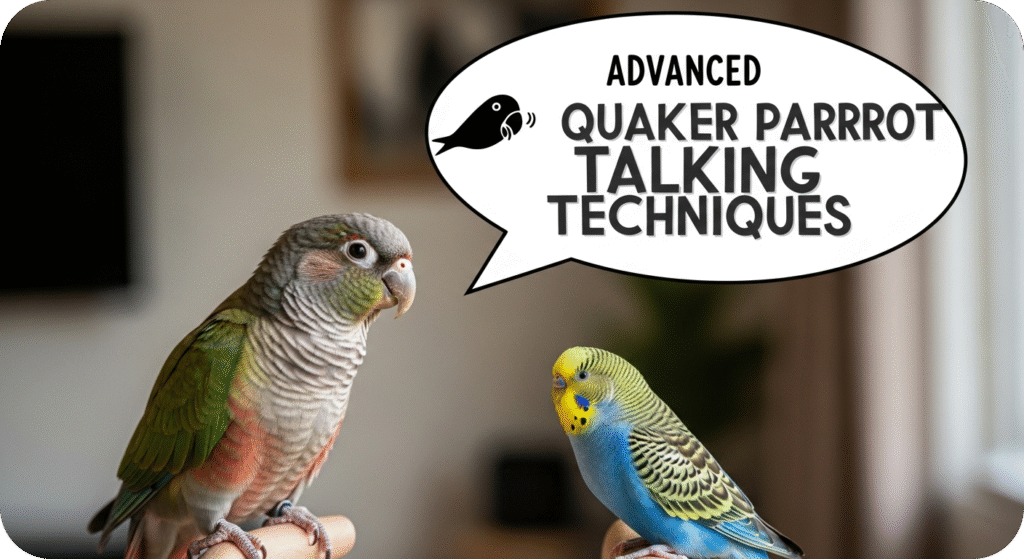
Developing Contextual Understanding
Once your Quaker parrot has mastered several basic words, you can begin fostering contextual understanding—the ability to use words appropriately in specific situations. This advanced skill represents the transition from simple mimicry to more meaningful communication. Quaker parrots have demonstrated remarkable ability in this area, with many owners reporting their birds using greetings, farewells, and other phrases in appropriate contexts without specific training for each situation .
To develop contextual understanding, create consistent verbal routines around daily activities. For example:
- Always say “good morning” when uncovering the cage or as your first interaction of the day.
- Say “hello” or “hi” each time you enter the room where your bird is housed.
- Use “good night” consistently when covering the cage at bedtime.
- Say “bye-bye” when leaving the house or when family members depart.
These consistent associations help your Quaker recognize patterns and appropriate usage contexts. Many Quakers naturally begin to generalize these greetings, using them not only with the trained person but with visitors or in similar situations. This demonstrates cognitive processing beyond simple repetition and represents a significant milestone in your Quaker’s vocal development.
Building Phrases and Simple Sentences
After your Quaker parrot has mastered several individual words with contextual understanding, you can begin connecting these into phrases and simple sentences. This progression happens naturally for many Quakers, as they often combine learned elements in novel ways based on observation and pattern recognition .
To facilitate phrase development, begin introducing two-word combinations once your bird consistently uses individual words appropriately. For example, if your Quaker says “hello” and knows your name, you might model “hello [name]” when greeting them. Use the same clear enunciation and consistent tone you employed for single words, presenting the phrase as a single unit rather than separate words.
Many Quaker parrots demonstrate an impressive ability to create their own meaningful combinations from previously learned elements. One owner reported her Quaker spontaneously combining phrases when disturbed by nighttime noise, saying “Shelly! Be quiet! C’mon. Time to go night-night” . While this level of sophistication isn’t guaranteed, it illustrates the potential of these birds to move beyond simple mimicry to create novel utterances that serve specific communication purposes.
Teaching Songs and Musical Elements
Quaker parrots often show particular aptitude for learning songs and musical sequences, making this an enjoyable aspect of advanced vocal training. Their natural appreciation for music, combined with their vocal abilities, enables them to learn surprisingly complex melodic patterns.
Begin with simple, repetitive songs or nursery rhymes that have a clear melodic structure. Sing these consistently to your Quaker during relaxed, positive interactions. As with word training, maintain consistency in your delivery to help your bird recognize and replicate the pattern. Some owners find that whistling simple tunes first establishes melodic understanding before introducing words set to music.
Breaking longer songs into shorter segments can facilitate learning. Teach the first few notes until mastered, then gradually add subsequent segments. The process requires considerable patience, as complex songs may take weeks or months to fully master. However, the result—a singing Quaker parrot—provides unique entertainment and demonstrates the remarkable vocal capabilities of these birds.
Troubleshooting Common Challenges in Quaker Parrot Talking
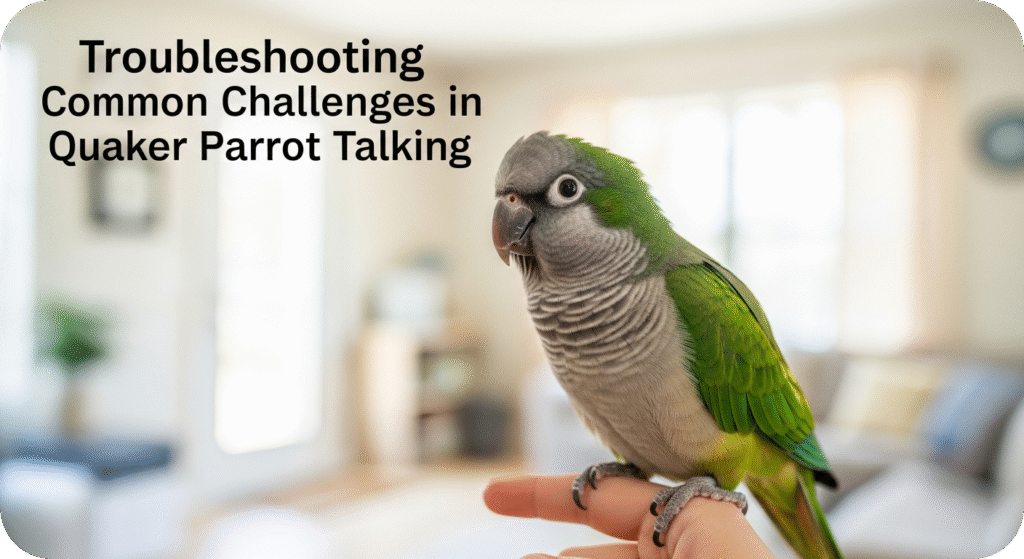
Addressing Reluctance to Vocalize
Some Quaker parrots may show hesitation or reluctance to attempt human speech despite their species’ reputation for talking ability. If your bird isn’t showing progress with initial training, consider these potential solutions:
- Health Assessment: Schedule a check-up with an avian veterinarian to rule out physical issues that might affect vocalization, such as respiratory problems or nutritional deficiencies . A healthy bird is more likely to engage in vocal behavior.
- Environmental Stressors: Evaluate your Quaker’s environment for potential stress factors like excessive noise, insufficient sleep, presence of predators (including other household pets), or too much/little stimulation . Stress significantly inhibits vocal experimentation.
- Bonding Issues: If the bond between you and your Quaker is still developing, focus on strengthening your relationship through positive interactions that don’t pressure the bird to perform. Forced training sessions with an untrusting bird typically yield poor results.
- Personality Acceptance: Recognize that individual personality plays a significant role in talking behavior. Some Quakers are naturally less vocal, much like some humans are more soft-spoken. In such cases, celebrate smaller vocal achievements rather than focusing exclusively on extensive vocabulary.
Often, addressing these fundamental issues creates the conditions where previously reluctant Quakers begin experimenting with vocalizations more freely. Patience and adjustment of expectations are essential when working with a bird that doesn’t immediately demonstrate talking aptitude.
Correcting Unwanted Vocalizations and Screaming
While most owners want their Quaker parrots to vocalize, excessive screaming or undesirable sounds can become problematic. It’s important to distinguish between normal vocalization (which can be quite loud) and true behavioral screaming issues:
- Identify Triggers: Observe patterns in screaming behavior to identify potential triggers such as loneliness, boredom, fear, or attention-seeking. Addressing the underlying cause is more effective than simply trying to stop the behavior.
- Appropriate Response: When screaming occurs for attention, avoid reinforcing the behavior by responding directly. Instead, wait for a moment of quiet before providing attention, thus rewarding silence rather than noise .
- Environmental Enrichment: Provide adequate mental stimulation through toys, foraging opportunities, and environmental variety to prevent boredom-related screaming . A mentally engaged Quaker is less likely to develop persistent screaming habits.
- Covering Technique: For particularly persistent screaming, some experts recommend temporarily covering the cage for brief periods (5-10 minutes) to encourage calmness . However, this should be used judiciously and not as punishment.
Remember that vocalization is natural parrot behavior, and complete silence is an unrealistic expectation. The goal is to shape vocal behavior toward more desirable sounds like speech rather than attempting to eliminate vocalization entirely.
Maintaining and Expanding Quaker Parrot Talking Skills
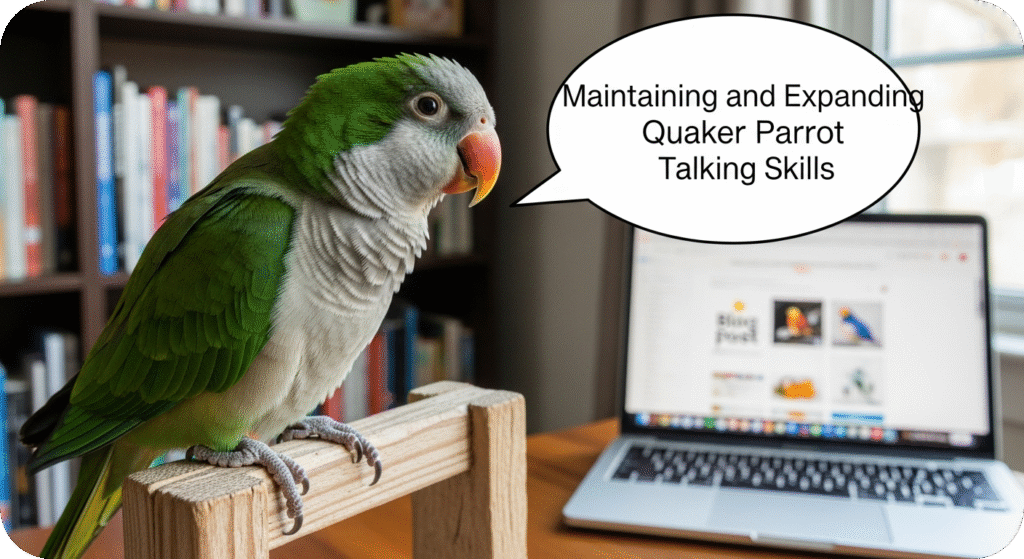
Long-Term Vocabulary Development
Once your Quaker parrot has established a basic vocabulary and understands the process of learning new words, you can implement strategies for long-term vocabulary development:
- Progressive Learning: Continue introducing new words and phrases regularly, but avoid overwhelming your bird with too many new elements at once. A good rule is to introduce a new word every 1-2 weeks once the previous word is consistently used.
- Category Expansion: Develop vocabulary in categories such as greetings, food names, family member names, and action words. This categorical approach may help your Quaker organize and retrieve words more effectively.
- Vocabulary Maintenance: Regularly use all words in your Quaker’s vocabulary, not just the newest additions. Parrots can forget infrequently used words, so maintaining their full repertoire requires ongoing practice.
- Complexity Progression: Gradually increase the complexity of phrases as your bird demonstrates readiness. Moving from single words to two-word phrases, then simple sentences, provides appropriate challenge without causing frustration.
This progressive approach to vocabulary development can result in impressive vocabularies over time, with some Quaker parrots learning dozens or even hundreds of words and phrases throughout their lives.
Incorporating Talking into Daily Interactions
The most successful Quaker parrot talking development occurs when vocal practice extends beyond formal training sessions into daily interactions. Integrate talking practice naturally throughout your day by:
- Running Commentary: Provide verbal descriptions of your actions when interacting with your Quaker, such as “I’m filling your food bowl” or “Time for a shower.” This constant exposure to language in context supports both vocabulary acquisition and understanding.
- Responsive Conversation: When your Quaker says a word or phrase, respond appropriately as you would in human conversation. If your bird says “hello,” respond with “hello” followed by their name or a positive comment. This interactive exchange reinforces the social function of vocalization.
- Family Participation: Encourage all family members to use consistent vocabulary and interact verbally with your Quaker. Exposure to different voices can enhance vocal flexibility, though the bird may still prefer the voice of its primary caregiver.
- Game Integration: Incorporate words and phrases into play activities. For example, say “up” when lifting your bird or “ball” when playing with a small toy. This association of language with enjoyable activities creates positive reinforcement.
When talking becomes integrated into the fabric of your daily relationship rather than remaining a separate training activity, your Quaker parrot more readily incorporates human speech into its natural communication repertoire.
Health and Wellness Considerations for Optimal Vocalization
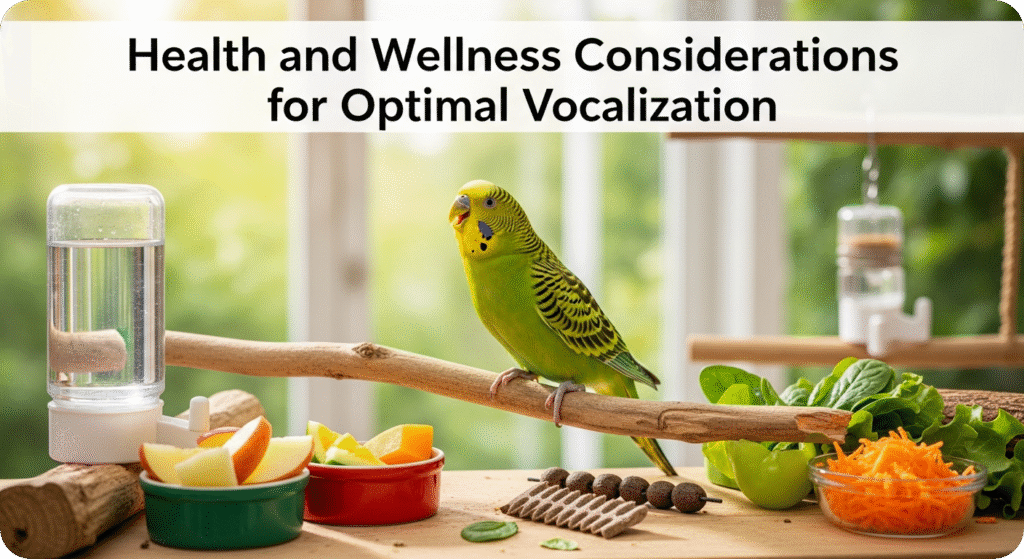
Physical Health Requirements for Clear Speech
A Quaker parrot’s ability to produce clear speech depends significantly on its physical health. Several health factors directly impact vocal quality and consistency:
- Respiratory Health: Since parrot vocalization depends on the syrinx and respiratory system, any respiratory issues can affect voice production and quality. Watch for signs of breathing difficulties and maintain a clean, dust-free environment.
- Nutritional Support: Proper nutrition supports the energy requirements for vocalization and maintains healthy respiratory tissue. A balanced diet of high-quality pellets, fresh vegetables, and limited fruits provides essential vitamins and minerals . Specifically, vitamin A supports respiratory health and may contribute to clear vocalization.
- Weight Management: Obesity can impact respiratory efficiency and overall energy levels. Monitor your Quaker’s weight and body condition, adjusting diet and exercise as needed to maintain optimal health .
- Regular Veterinary Care: Annual check-ups with an avian veterinarian help identify and address health issues before they significantly impact vocal ability . Be sure to mention any changes in your bird’s voice or vocal behavior during these visits.
A comprehensive approach to physical health creates the foundation upon which advanced vocal skills can be built and maintained throughout your Quaker’s life.
Mental Health and Emotional Well-being
The connection between mental health and vocal behavior in Quaker parrots is significant. These intelligent birds require adequate mental stimulation and emotional security to engage in vocal learning and practice:
- Environmental Enrichment: Provide a stimulating environment with rotating toys, foraging opportunities, and safe exploration spaces to prevent boredom and support cognitive development .
- Social Interaction: As highly social creatures, Quakers require regular, positive interaction with their human flock. Isolation or neglect can lead to decreased vocalization or other behavioral issues .
- Routine and Security: Maintain consistent daily routines that provide a sense of security. Knowing what to expect throughout the day reduces stress and creates the emotional safety necessary for vocal experimentation.
- Positive Association: Ensure that vocal practice remains associated with positive experiences rather than pressure or frustration. If training sessions become stressful, return to simpler, more enjoyable interactions to rebuild positive associations.
By supporting both the physical and mental health of your Quaker parrot, you create optimal conditions for the development and maintenance of impressive talking abilities throughout their potentially 25-30 year lifespan .
FAQs About Quaker Parrot Talking

Q1: At what age should I start training my Quaker parrot to talk?
You can begin talking training as soon as your Quaker parrot has settled into its new home and established basic trust with you. Younger birds, particularly those under one year old, often show particular enthusiasm for picking up new words and sounds . However, birds of any age can learn to talk with patience and consistent training.
Q2: How many words can a Quaker parrot learn?
The vocabulary capacity of Quaker parrots varies by individual, but many develop vocabularies of several dozen words or more. Some exceptional individuals learn hundreds of words and phrases throughout their lives. The consistency of training, the bird’s individual aptitude, and the richness of its language environment all influence ultimate vocabulary size.
Q3: Why does my Quaker parrot mumble or talk quietly?
Quiet or mumbled speech can indicate several things: your bird may be practicing new words before using them confidently, it may be contentedly “conversing” with itself, or it might not feel fully comfortable vocalizing loudly. Ensure your bird feels secure in its environment, and continue providing enthusiastic reinforcement for all vocal attempts.
Q4: Can Quaker parrots understand what they’re saying?
Research and owner observations suggest that Quaker parrots can develop contextual understanding of words and phrases, using them appropriately in specific situations . While the extent of their comprehension differs from human understanding, they demonstrate an impressive ability to associate words with meanings, objects, or actions.
Q5: Is it better to have one or two Quaker parrots for talking development?
A single Quaker parrot with ample human interaction often develops stronger speech skills, as it views humans as its social flock and seeks to communicate with them . Two Quakers may bond primarily with each other and direct less vocal energy toward human speech, though some talking ability can still develop.
Q6: Why has my Quaker parrot stopped talking?
A previously vocal Quaker that stops talking may be experiencing health issues, stress, or environmental changes. Schedule a veterinary visit to rule out physical causes, then evaluate recent changes in household routine, environment, or social dynamics that might affect your bird’s vocal behavior.
Q7: Can I teach my Quaker parrot to have conversations?
While parrots don’t engage in conversations with human-level complexity, many Quaker parrots learn to use phrases appropriately in back-and-forth exchanges that resemble simple conversations. With training, some birds learn to answer questions, make requests, or offer context-appropriate comments in interactive exchanges.
Conclusion: The Joy of Talking With Your Quaker Parrot
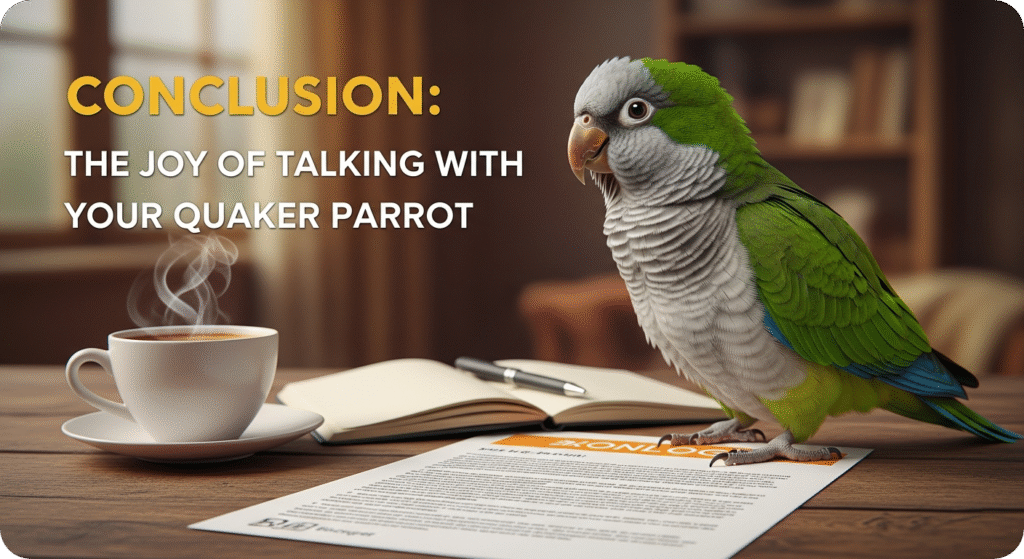
Developing the talking abilities of your Quaker parrot represents one of the most rewarding aspects of living with these intelligent birds. The process strengthens your bond, provides mental stimulation for your bird, and creates a unique form of interspecies communication that never fails to delight and amaze. Remember that success in talking training depends on patience, consistency, and understanding your individual bird’s personality and learning style.
The journey of vocal development continues throughout your Quaker’s life, with new words, phrases, and vocal skills emerging over years of companionship. Celebrate each milestone, from the first clear word to complex phrases and appropriate contextual usage. These vocal achievements demonstrate not just mimicry but the remarkable cognitive abilities of Quaker parrots.
By applying the techniques and principles outlined in this guide, you can help your Quaker parrot reach its full vocal potential while enjoying the deep, meaningful relationship that comes from this shared form of communication. The result is a companion who doesn’t just live in your home but actively participates in it through the unique gift of speech.

Leave a Reply